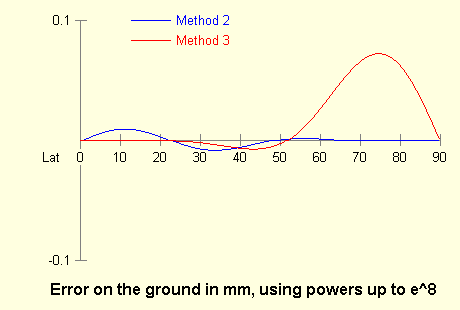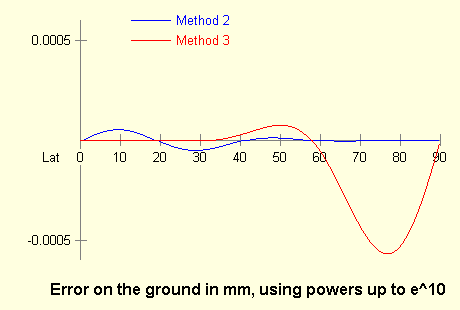If the Earth is modelled as an oblate spheroid with eccentricity e, then the isometric latitude ψ
is defined in terms of the geographic latitude φ by
| ψ | = |
tanh−1(sinφ) − e tanh−1(e sinφ). |
|
(1) |
The problem is to invert (1) and find φ when ψ is given. We do this here by finding sinφ.
For other approaches, see e.g. Wolfram MathWorld
[1].
If we define s = sinφ then (1) becomes
| ψ | = |
tanh−1(s) − e tanh−1(es), |
|
(2) |
and we require s given ψ. Three methods are briefly described below.
Method 1: Iteration
This is straightforward. Starting with s0 = tanh ψ,
or better
s0 = tanh ψ / (1 − e2),
we iterate
| sn+1 | = |
tanh(ψ + e tanh−1(esn)) |
|
until the desired accuracy has been achieved.
Method 2: Power series obtained by iteration
Write t = tanh ψ. From (2)
| ψ | = |
tanh−1(s) − e2s
− e4s3/3
− e6s5/5
− … |
|
whence
| s | = |
tanh(ψ + e2s
+ e4s3/3
+ e6s5/5
+ …). |
|
Substituting the first approximation s = t in the RHS gives
| s | = |
tanh(ψ + e2t) + O(e4)
= (1 + e2)t − e2t3 + O(e4). |
|
Substituting the second approximation s = (1 + e2)t − e2t3
gives a third approximation with error O(e6), and so on.
Taking the approximation up to terms in e12, with error O(e14),
we find
| sinφ | = |
F1(e)t − F3(e)t3
+ F5(e)t5 − F7(e)t7
+ F9(e)t9 − F11(e)t11
+ F13(e)t13 − … |
|
where
|
F1(e) | = |
1 + e2 + e4 + e6
+ e8 + e10 + e12 + …
|
|
F3(e) | = |
e2 + (8/3)e4 + 5e6
+ 8e8 + (35/3)e10 + 16e12 + …
|
|
F5(e) | = |
(5/3)e4 + (36/5)e6
+ (293/15)e8 + (127/3)e10 + 80e12 + …
|
|
F7(e) | = |
(16/5)e6 + (6 017/315)e8
+ (21 319/315)e10
+ (58 111/315)e12 + …
|
|
F9(e) | = |
(2 069/315)e8
+ (1 751/35)e10
+ (619 831/2 835)e12 + …
|
|
F11(e) | = |
(883/63)e10
+ (2 892 031/22 275)e12 + …
|
|
F13(e) | = |
(1 594 444/51 975)e12 + …
|
| | …. |
|
It may be more convenient to rearrange this as a power series in e2.
Method 2 thus becomes:
| sinφ | = |
t + e2 t (1 − t2)[1
+ G1(t)e2
+ G2(t)e4
+ G3(t)e6 + …] |
|
where
| G1(t) | = |
1 − (5/3)t2, |
| G2(t) | = |
1 − 4t2 + (16/5)t4, |
| G3(t) | = |
1 − 7t2 + (188/15)t4
− (2069/315)t6, |
| G4(t) | = |
1 − (32/3)t2 + (95/3)t4
− (11 344/315)t6
+ (883/63)t8, |
| G5(t) | = |
1 − 15t2 + 65t4
− (37 636/315)t6
+ (281 107/2 835)t8
− (1 594 444/51 975)t10, |
| | …. |
|
2016-10-22 Corrected the following errors.
The coefficient 16/5 in F7 was mistyped as16/15.
The coefficient 188/15 in G3 appeared as 1316/105 (correct value, but not in its lowest terms).
Method 3: Another power series method
If we define ε = e 2 / (1 − e 2),
then up to O(e14) the first two F’s in the preceding method are given by
| F1(e) | = |
1 + ε, |
|
F3(e) | = |
(1 + ε)(3 + 2ε)ε/3. |
|
In fact these expressions are exact, and all the F’s are finite polynomials in ε.
To see this, note that (2) gives
| d s |
= |
(1 − s2)(1 − e2s2) |
= |
(1 − s2)(1 + ε − ε s2) |
. |
| d t |
(1 − e2)(1 − t2) |
(1 − t2) |
|
Consequently, if we set
| dn s |
= |
(1 − s2)(1 + ε − ε s2) |
∑ | c(n; i, j)sitj |
| d tn |
(1 − t2)n |
|
then after some routine calculation we find the recurrence
| c(n + 1; i, j) | = |
ε(i + 1)c(n; i − 3, j)
− (i + 1)(1 + 2ε)c(n; i − 1, j)
+ (i + 1)(1 + ε)c(n; i + 1, j) |
| |
|
+ (2n − j + 1)c(n; i, j − 1)
+ (j + 1)c(n; i, j + 1), |
|
from which the dn s/d tn
can be calculated for n = 1, 2, 3, ….
Hence we obtain s as a power series in t,
| sinφ | = |
(1 + ε) [ t
− εP3(ε)t 3
+ ε2P5(ε)t 5
− ε3P7(ε)t 7
+ ε4P9(ε)t 9
− … ] , |
|
(3) |
where
| 3P3(ε) | = |
3 + 2ε, |
| 15P5(ε) | = |
25 + 33ε + 11ε2, |
| 315P7(ε) | = |
1 008
+ 1 985ε
+ 1 314ε2
+ 292ε3, |
| 2 835P9(ε) | = |
18 621
+ 48 726ε
+ 48 160ε2
+ 21 288ε3
+ 3 548ε4, |
| 155 925P11(ε) | = |
2 185 425
+ 7 131 667ε
+ 9 368 049ε2
+ 6 187 111ε3
+ 2 053 245ε4
+ 273 766ε5, |
| 6 081 075P13(ε) | = |
186 549 948
+ 729 283 824ε
+ 1 194 598 888ε2
+ 1 048 861 221ε3
+ 520 345 408ε4
+ 138 241 602ε5
+ 15 360 178ε6, |
| 638 512 875P15(ε) | = |
43 645 743 540
+ 198 807 682 245ε
+ 390 064 483 656ε2
+ 427 111 938 764ε3
+ 281 769 302 772ε4
+ 111 954 199 526ε5
+ 24 798 632 628ε6
+ 2 361 774 536ε7, |
| 10 854 718 875P17(ε) | = |
1 675 357 363 125
+ 8 712 734 726 988ε
+ 19 914 368 526 088ε2
+ 26 118 610 367 256ε3
+ 21 491 782 658 226ε4
+ 11 358 058 960 776ε5
+ 3 763 853 754 228ε6
+ 714 894 255 024ε7
+ 59 574 521 252ε8, |
| 1 856 156 927 625P19(ε) | = |
653 523 328 781 091
+ 3 820 411 433 944 980ε
+ 9 967 712 402 926 242ε2
+ 15 228 851 331 982 346ε3
+ 15 010 468 930 152 492ε4
+ 9 895 994 198 275 836ε5
+ 4 362 794 587 093 944ε6
+ 1 240 022 346 019 032ε7
+ 206 147 974 037 364ε8
+ 15 270 220 299 064ε9, |
| | …. |
|
It may be more convenient to rearrange this as a power series in ε.
Method 3 thus becomes:
| sinφ | = |
t + ε t (1 − t2)[1
+ Q1(t)ε
+ Q2(t)ε2
+ Q3(t)ε3 + …] |
|
where
| Q1(t) | = |
−(5/3) t2, |
| Q2(t) | = |
−(2/15) t2 (5 − 24t2), |
| Q3(t) | = |
(1/315) t4 (924 − 2 069t2), |
| Q4(t) | = |
(1/315) t4 (231
− 3 068t2
+ 4 415t4), |
| Q5(t) | = |
−(2/155 925) t6 (397 485
− 2 266 880t2
+ 2 391 666t4), |
| | …. |
|
Discussion
The diagrams show the error on the ground when one includes terms up to and including
e8 and e10 respectively. Method 3 has a lower error than Method 2
up to about 30° latitude, but is much worse around 70°–80°.


For a method that suits all latitudes, it seems best therefore to use either
iteration
or Method 2.
The maximum error on the ground with Method 2 is as follows:
| Highest power of e included |
6 |
8 |
10 |
12 |
| Maximum error on ground in mm |
1.9 |
0.010 |
5.9 × 10−5 |
3.4 × 10−7 |
Reference
[1] http://mathworld.wolfram.com/IsometricLatitude.html

